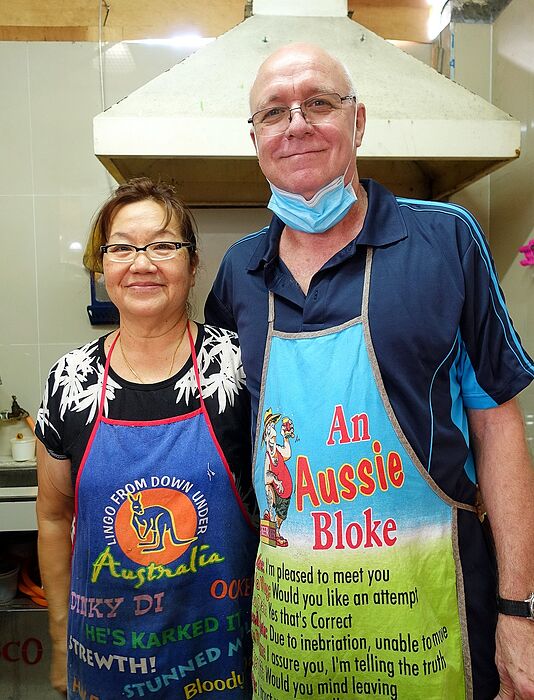The Penang-Perth connection: the husband & wife team of Kim and Richard Spicer’s unique take on Penang-Nyonya kerabu beehoon & nasi ulam at Tanjung Bungah Market’s little neighbourhood hawker centre:
Penang-born Kim does all the cooking, whilst Perthite, Richard, takes orders and handles the cash.
Kerabu bee hoon is essentially a spicy, rice vermicelli salad, served at room temperature. It gets its main flavours from a myriad of traditional ingredients in the dressing: sambal belacan (chili-lime-fermented shrimp paste), raw onions, lemongrass, torch ginger, kerisik (toasted, grated coconut), etc. Kim’s version seemed to tone down on the “sambal belacan” quotient - fine for me, who’s really not into chili-spicy food, but am not too sure how other Penangites feel about this. Also, the “kerisik” and torch ginger were not evident.
But Kim makes up for it by providing delicate slices of fried tofu, crisp fried anchovies and groundnuts for some extra textural crunch, fresh pineapple & cucumber slices and sprigs of mint.
Nasi ulam - was the other dish we had: a rice salad usually served cold/at room temperature, and usually tossed with some aromatic herbs and spices like laksa leaves (Vietnamese coriander), fresh lemongrass, fresh turmeric root, mint leaves, wild betel leaves, torch ginger, lime leaves, Thai basil, etc. Here, again, Kim made her own version, where she dialed down on the more pungent herbs, and made up for its with her anchovy-groundnut topping, and fresh pineapples-cucumber-mint leaves trinity.
We were pretty full from the carb-heavy meal, and chose to take-out the third option on their menu: the Malaysian nasi lemak, tinted blue using the natural colours of the butterfly pea flower, and served with a piece of turmeric-marinated fried chicken and a hard-boiled egg.
The Spicers have actually stumbled upon the secret of having a 3-day work-week. They sell their popular Nyonya staples out by mid-morning usually, and only operate on Sat, Sun & Mon, from 6am till everything is finished, about 10am.
Address
Nyonya Kim, Stall #A14
Tanjung Bungah Market & Food Complex
Jalan Sungai Kelian, Tanjung Tokong
11200 Tanjung Bungah, Pulau Pinang
Tel: +601162484183
Opening hours: 6am till 10am, Sat, Sun & Mon only








